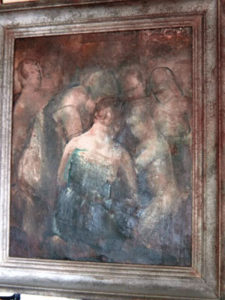 MV’s dad asked his daughter to send me a photograph of a 20 x 24″ oil on canvas signed on the back (signed verso) by Grigori Gluckmann (Grigori Efimovich Gluckmann, Russian 1898-1973). MV said a gallery label reads 28-5-10, but Europeans often write dates strangely. The date is actually May 5, 1930. Not just a gallery label, it says “Salon des Tuileires, 1930,” not just any gallery. This oil on canvas bears the title “Composition.”
MV’s dad asked his daughter to send me a photograph of a 20 x 24″ oil on canvas signed on the back (signed verso) by Grigori Gluckmann (Grigori Efimovich Gluckmann, Russian 1898-1973). MV said a gallery label reads 28-5-10, but Europeans often write dates strangely. The date is actually May 5, 1930. Not just a gallery label, it says “Salon des Tuileires, 1930,” not just any gallery. This oil on canvas bears the title “Composition.”
A lot went on in Paris in 1930. From the late 19th century until World War II, people considered Paris the center of the art world. Artists, intellectuals, musicians descended upon Paris. They drank in the atmosphere of the revolutionary French Impressionists, who changed the direction of art. By the 1930’s the time was ripe for another innovative period in the arts…enter the School of Paris. Grigori Gluckmann was of this school, and your dad owns a great work of Modernist Art. I’m glad you wrote me, MV.
Gluckmann Lands in Paris
Gluckmann studied classical painting at the Moscow Ecole des Beaux Arts, got caught up in the Russian Revolution, escaped to Germany. Then when Germany got hot, he left to study the Masters of the Renaissance in Italy. Landing in Paris in 1924, the famous Galerie Druet on the Rue Royale picked his work. His paintings are well composed and easily read, more realistic than expressionist, and usually involved female nudes or female dancers/musicians. The next year he broke Paris open at the big three shows: the Salon des Tuileries, the Salon d’Automne and the Salon National des Beaux Arts. Afterwards he sold and showed in London and New York.
Like many artists trained in Moscow, Gluckmann needed to develop a style which didn’t have to reside on a canvas support. Canvas became hard to find in early 20th century Russia so he developed a technique of painting on layers on wood. You see this technique softens the shapes and lines, perfect for the female forms.
1930, a Fertile Year for Artists and Intellectuals
A lot happened in ART when Gluckmann painted your this oil. Arguably the most famous modern show of all took place, the Societe des Artistes Decorateurs, Exposition 1930, at the Paris Grand Palais. Also in 1930 the Salon de l’Ecole Francaise, the December Salon d’Automne, the Salon Societes des Artistes Independants, the Congres International d’Archeologie, and the Salon des Femmes Peintre et Sculpteurs occurred.
1934 also became a great year for Gluckmann when he exhibited a solo Paris show at Gallerie Charpentier. In that year he befriended the renowned violinist Jascha Hifetz, who introduced Gluckmann to the world of the concert stage. Gluckmann titled this oil “Composition,” which refers to a group of dancers in a circular composition on stage. He preferred the company of musicians and intellectuals rather than his fellow painters. Mostly Gluckmann held to the great French tradition of painting sensual female forms found among the Parisian nightlife.
Enter World War II
All this came to an abrupt end during the German occupation of Paris. In 1941 Gluckmann immigrated to New York, but he still showed his work during the war. Like many European Jewish intellectuals, he came to Los Angeles in the mid 1940’s, showing there at the Dalzell Hatfield Galleries in the Ambassador Hotel on Wilshire Blvd, where he sold to celebrities.
Gluckmann returned to paint Paris only one more time, in 1954. He showed at the Galerie Drouant-David, and returned to LA to become an American citizen. MV, tell your dad his painting is worth plenty. Here’s the sales of three other paintings by Gluckmann: “Before the Performance,” 12×20″, selling in 2009 at Sotheby’s for $35,000, “Backstage,” painted 1928-9, 35×27″ at Sotheby’s, also in 2009 for $59,375 and a more recent sale of “Femme Nu,” a full spread nude, 13×16″ selling at Skinners for $27,255. SCORE!!